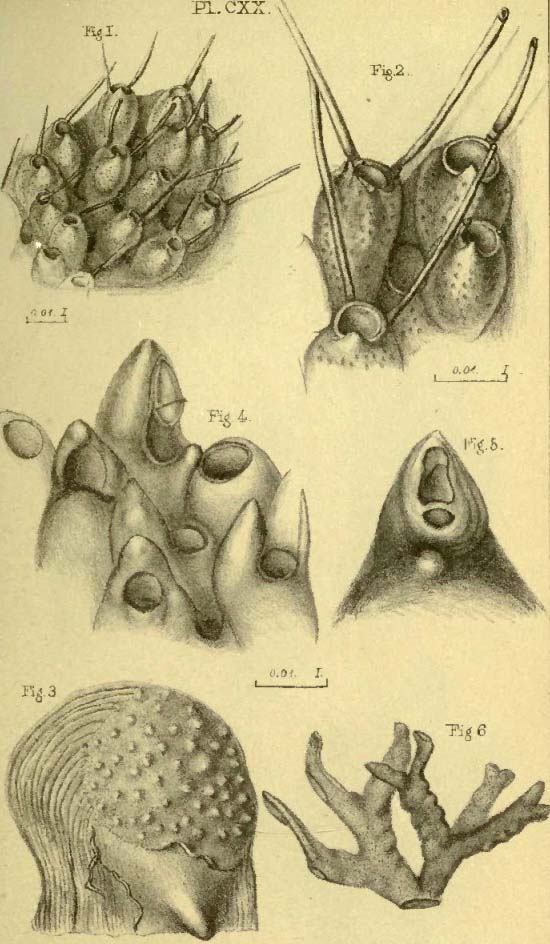[page i]
CATALOGUE
OF
MARINE POLYZOA
IN
THE COLLECTION
OF THE
BRITISH MUSEUM.
PART II.
CHEILOSTOMATA (PART.).
LONDON:
PRINTED BY ORDER OF THE TRUSTEES.
1854.
[page iii]
NOTICE.
IN the present Catalogue it is intended to comprise figures and descriptions of all the species of Marine Polyzoa in the Collection of the British Museum, and from typical specimens therein contained.
This Collection, already valuable, especially in the possession of Dr. Johnston's specimens, has recently been materially augmented by the addition of numerous Australian and other forms, many of them new, procured by Mr. J. Macgillivray, on the voyage of H. M. S. Rattlesnake. It has also been much enriched by the liberality of Charles Darwin, Esq., F.R.S., Dr. J. Hooker, F.R.S., Dr. Lyall, R.N., R. McAndrew, Esq., F.R.S., J.S. Bowerbank, Esq., F.R.S., The Rev. David Landsborough, Mrs. Gatty, Miss Cutler, Professor Edward Forbes, F.R.S., Dr. Greville, J. Hyndman, Esq., Joshua Alder, Esq., Dr. W. Stanger, the late W. Thompson, Esq., of Belfast, and others, who have
[page] iv
placed their collections at Mr. Busk's disposal, for the purposes of this Catalogue, and for the selection of the specimens required for the Museum Collection.
The Catalogue has been prepared, and the drawings made, by Mr. GEORGE BUSK, F.R.S., who has also superintended the execution of the lithography. The magnified figures have in all cases been taken from nature, and for the most part from specimens preserved in fluid, in order to ensure a more natural aspect than that afforded by dried specimens. As they have been drawn with the aid of the camera lucida, and to a scale which is given with each plate or figure, the absolute and relative proportions of the different objects will be at once obvious.
JOHN EDWARD GRAY.
1 Dec. 1853.
[page v]
LIST OF SPECIES.
| Family | 10. | MEMBRANIPORIDÆ | 55 |
| Gen. | 1. | Membranipora | 56 |
| 1. | M. membranacea | 56 | |
| 2. | M. pilosa | 56 | |
| 3. | M. coriacea | 57 | |
| 4. | M. umbonata | 57 | |
| 5. | M. lincata | 58 | |
| 6. | M. Flemingii | 58 | |
| 7. | M. Rozieri | 59 | |
| 8. | M. Rosselii | 59 | |
| 9. | M. calpensis | 60 | |
| 10. | M. stenostoma | 60 | |
| 11. | M. cerviconis | 60 | |
| 12. | M. Lacroixii | 60 | |
| 13. | M. cyclops | 61 | |
| 14. | M. monostachys | 61 | |
| 15. | M. magnilabris | 62 | |
| 16. | M. galeata | 62 | |
| Gen. | 2. Lepralia | 63 | |
| * Armatæ | |||
| 1. | L. Brongniartii | 65 | |
| 2. | L. Landsborovii | 66 | |
| 3. | L. galeata | 66 | |
| 4. | L. reticulata | 66 | |
| 5. | L. Marionensis | 67 |
[page] vi
| 6. | Lepralia auriculata | 67 | |
| 7. | L. concinna | 67 | |
| 8. | L. verrucosa | 68 | |
| 9. | L. violacea | 69 | |
| 10. | L. spinifera | 69 | |
| 11. | L. trispinosa | 70 | |
| 12. | L.coccinea | 70 | |
| 13. | L. linearis | 71 | |
| 14. | L. alata | 71 | |
| 15. | L. monoceros | 72 | |
| 16. | L. bicristata | 72 | |
| 17. | L. margaritifera | ||
| 18. | L. ciliata | 73 | |
| 19. | L. Gattyæ | 73 | |
| 20. | L. Hyndmanni | 74 | |
| 21. | L. personata | 74 | |
| 22. | L. depressa | 75 | |
| 23. | L. Lyallii | 75 | |
| ** Inarmatæ | |||
| 24. | L. variolosa | 75 | |
| 25. | L. nitida | 76 | |
| 26. | L. annulata | 76 | |
| 27. | L. bispinosa | 77 | |
| 28. | L. Peachii | 77 | |
| 29. | L. ventricosa | 78 | |
| 30. | L. melolontha | 78 | |
| 31. | L. innominata | 79 | |
| 32. | L. punctata | 79 | |
| 33. | L. figularis | 80 | |
| 34. | L. pertusa | 80 | |
| 35. | L. pallasiana | 81 | |
| 36. | L. cucullata | 81 | |
| 37. | L. labiosa | 82 | |
| 38. | L. labrosa | 82 | |
| 39. | L. simplex | 82 | |
| 40. | L. areolata | 82 | |
| 41. | L. adpressa | 82 | |
| 42. | L. Malusii | 83 | |
| 43. | L. granifera | 83 | |
| 44. | L. hyalina | 84 | |
| 45. | L. discreta | 85 | |
| 46. | L. annularis | 85 |
[page vii]
| Fam. | 11. CELLEPORIDÆ | 85 |
| Gen. | 1. Cellepora | 85 |
| * Adnate | ||
| 1. C. pumicosa | 86 | |
| 2. C. Hassallii | 86 | |
| 3. C. vitrina | 87 | |
| 4. C. bispinata | 87 | |
| 5. C. mamillata | 87 | |
| ** Erect | ||
| 6. C. ramulosa | 87 | |
| 7. C. Skenei | 88 | |
| 8. C. fusca | 88 | |
| Fam. | 12. ESCHARIDÆ | 88 |
| Gen. | 1. Eschara | 89 |
| 1. E. foliacca | 89 | |
| 2. E. contorta | 89 | |
| 3. E. urccolata | 90 | |
| 4. E. platalea | 90 | |
| 5. E. lichenoides | 90 | |
| 6. E. fuegensis | 90 | |
| 7. E. decussata | 91 | |
| 8. E. flabellaris | 91 | |
| 9. E. gracilis | 91 | |
| 10. E. gigantea | 91 | |
| 11. E. cervicornis | 92 | |
| Gen. | 2. Retepora | 93 |
| 1. R. cellulosa | 93 | |
| 2. R. beaniana | 94 | |
| 3. R. phœnieea | 94 | |
| Fam. | 13. VINCULARIADÆ | 95 |
| Gen. | 1.Vincularia | 96 |
| 1. V. ornata | 96 |
[page viii]
| Fam. | 14. SELENARIADÆ | 97 |
| Gen. | 1. Cupularia | 97 |
| 1. C. guineensis | 98 | |
| 2. C. Owenii | 99 | |
| 3. C. Lowei | 99 | |
| 4. C. stellata | 99 | |
| 5. C. pyriformis | 100 | |
| Gen. | 2. Lunulites | 100 |
| 1. L. gibbosa | 100 | |
| 2. L. capulus | 100 | |
| 3. L. philippinensis | 101 | |
| 4. L. cancellata | 101 | |
| Gen. | 3. Selenaria | 101 |
| 1. S. maculata | 101 |
[page 1]
CATALOGUE
OF
MARINE POLYZOA.
Fam. 10. MEMBRANIPORIDÆ
Char. Polyzoary membranaceo-calcareous or calcareous, expanded, encrusting, sometimes foliaceous, contorted and suberect. Cells horizontal, quincuncial or serial.
Flustra.Linn.
Flustradæ, Gray, Cat.B. M. 145, 1848.
Celleporidæ (part.), Johnston, Brit. Zooph. ed. 2. p. 263.
SYNOPSIS OF GENERA.
* Cells more or less open in front, with raised margins.
1. MEMBRANIPORA.
** Cells disposed in a radiate manner; closed in front.
2. LEPRALIA.
[page] 59
Flustra Peachii, Couch, Rep.Cornw. Polytechnic Soc. 81 (see Johnst. Brit. Zooph. 478).
Amphiblestrum membranaceum, Gray, List B. R.110.
Hab. European Seas; Australia?: on stones and shells.
The above synonyms are assigned to this species chiefly on the authority of Dr. Johnston, but several of them are probably erroneous. No species presents greater diversities of form than the present; and specimens will occasionally be met with, especially from deep water, in which, from the almost entire absence of the spines and avicularia, great difficulty will be experienced in the determination; careful inspection, however, of various parts of the patch, especially at the growing edge, if it be in the growing state, will usually suffice to trace its relationship to the form assumed as the type of the species. The figures given in the different plates referred to, afford but a faint notion of the endless varieties induced by age, wear and situation, particularly as to depth, of this protean form. I have ventured to assign a new term to it, because the specific name 'membranacea' belongs, as I think, of priority, to another species; and Dr. Fleming's name, 'unicornis,' is so inapplicable that its retention seems scarcely justifiable.
7. MEMBRANIPORA ROZIERI. P1. LXV. fig. 6.
Front of cell elliptical; mouth orbicular, with a raised margin and small tuberosity on each side; an oval or elongated opening on each side of the front of the immediately below the mouth. Ovicell globose, carinate in front.
Flustra Rozieri, Audouin, Savigny, Egypt. pl. 8. fig. 9. Hab. Rio de Janeiro, Darwin. On fucus.
Notwithstanding the above habitat, from which only have I seen a specimen, collected by Mr. Darwin, there can be no doubt of the identity of the form with that so beautifully figured by Savigny.
8. MEMBRANIPORA ROSSELII. Pl. C. fig. 2.
Front of cells oval, wide, or elongated; the lower half of the area filled in by a calcareous granulated expansion; margin finely beaded. Ovicell flattened in front.
Flustra Rosselii, Audouin, Expl. 240; Savigny, Egypt. pl. 10. fig. 11.
Hab. Orkney, Coast of Devon (Start)?, Bowerbank. Bay of Gibraltar, M' Andrew, Landsborough.
[page] 60
9. MEMBRANIPORA CALPENSIS, n. sp.? Pl. CIV. figs. 5,6.
Front of cell oval, elongated; margins elevated, smooth; anterior surface of cell punctate.
Hab. Bay of Gibraltar, M' Andrew, Landsborough. Egean Sea, E. Forbes. On fuci, shells and stones, and sometimes scarcely attached to anything.
A fine and, apparently, abundant species which I am unable positively to reconcile with any published description, and therefore venture to assign a name to. It seems at present to be confined to the Mediterranean, but no figure at all approaching it occurs among those of Savigny, unless it be that of Flustra Latreillei, pl. 14. fig. 8.
10. MEMBRANIPORA STENOSTOMA, n. s. Pl. C. fig. 1.
Front of cell pyriform; margins elevated, smooth, not grooved; surface of cell smooth, or subgranular, a long spine on each side of the mouth, which is very narrow. Avicularia scattered over the polyzoary; mandible triangular acute.
Hab. Tasmania, Mrs. Smith (W. Thompson). East Falkland Islands, 4 to 10 fathoms, Darwin.
11. MEMBRANIPORA CERVICORNIS, n. s. Pl. C. fig. 3.
Front of cell oblong or oval; a strong and much-projecting process arising from each upper angle of the aperture, branching like a stag's born and bending over the front of the cell, usually meeting and inosculating; several other simple or forked, marginal spines. Ovicell galeate, crowned with a small avicularium? Hob.— ?
This very curious species is at once distinguishable by the processes on each side of the upper part of the cell, which projecting at a right angle, branch out in the manner of the antlers of a stag, and usually uniting in front by one or more of the branches, cover and protect the open front of the cell in a very effectual manner. The colour of the polyzoary is purplish.
12. MEMBRANIPORA LACHOIXII. Pl. LXIX. Pl. CIV. fig. 1.
Front of cell oval, either entirely occupied by a membrane, or partially filled in by a calcareous, granulated expansion all round the circumference, but wider inferiorly; margin granulated; usually an avicularium on either side below the aperture, and occasionally a marginal spine (usually obsolete or worn off) on each side above.
[page] 62
Lacroixii, to which, in the older state especially, it bears an extremely close resemblance, seems nevertheless to me to be quite distinct. It usually forms a delicate gauze-like coat upon shells and stones, and is then quite calcareous, though very delicate and thin; but it also occurs in a more membranaceous condition and growing in an irregular foliaceous form of a greenish colour (dry). The only specimen of this sort that has come under my notice was kindly furnished by Dr. Landsborough; it was found by Mr. Higham of Norwich in brackish water and in considerably sized masses. It can hardly, perhaps, be regarded as purely a marine form, and will be found I imagine more abundantly in rivers near the sea, or in shallow estuaries, than in the sea itself. It occurs in great plenty on shells and stones on the muddy bottom of the river Deben in Suffolk. I have also a specimen very like this species from St. Vincent, one of the Cape de Verde Islands.
15. MEMBRANIPORA MAGNILABRIS, n. s. Pl. LXV. fig.4.
Front of cell oval; upper margin semicircular, much raised; moveable lip very large, occupying the entire semicircular upper third of the front of the cell, remainder of the front of cell depressed, membranous or semicalcareous, punctured.
Hab. Abrolhos Islet (Atlantic), Darwin. Algoa Bay, Bowerbank. On shell.
Very remarkable for the large size of the cells and the very great dimensions of the moveable lip; this part, as usual, is composed of a semicircular rim of horny matter; but besides this, the membrane stretching across the semicircle is further supported by two slender bars of horny substance, which extend from the side of the base to the centre of the bow, where they meet. This species might be regarded as the type of the cheilostomatous Polyzoa, and from its comparatively large size would probably be an interesting subject for examination in the living state.
16. MEMBRANIPORA GALEATA, n. s. Pl. LXV. fig.5.
Front of cell oval; two pointed marginal spines on each side, towards the top. Ovicell galeate, widely open beneath, crowned with a large oblong avicularium.
Hab. East Falkland Islands, 4 to 10 fathoms, Darwin. On Laminaria.
Colour dark purple.
[page] 63
2. LEPRALIA.
Polyzoarium adnate, crustaceous, spreading from a centre in a more or less circular form; composed of contiguous or connected, calcareous, decumbent cells, the walls of which are complete in front.
Eschara (sp.), Moll, Seerinde; Pallas, Elench.
Lepralia, Johnst. Brit. Zooph. ed. 2. p. 300; Gray, List Brit. Rad. p. 148 (part.).
Berenicea, Flem. Brit. An. 533, 1828; not Lamx. Exp. 80, 1821; nor Peron.
Escharina, sp., M.-Edw. Lamk. Hist. ed. 2. ii. 230; Gray, App. p. 148.
Escharoide, sp.,M.-Edw. Lamk. Hist. ed. 2.ii. 259?
Cellepora, sp., Oken, Lehrb. Nat. 86, 1815; Audouin, Expl. Savigny, Egypt. (part.); Lamouroux (part.); Hagenow (part.).
Flustra, id. ib.; Lamouroux (part.).
Discopora, Lamarck, Hist. (part.); Gray, App. p. 148 (part.); Lamouroux, Exp. Meth. (part.)
Cribrillina, Herentia, Escharella, Porella, Celleporella (all spec.), Gray, App. List Brit. Rad. pp. 147, 148, 149.
The very great number of species included under the above generic definition renders some subdivision of them indispensably requisite for the convenient determination of any particular form. In the absence of more precise knowledge respecting the living animals, we are not, I conceive, at present in a condition to propose a satisfactory natural arrangement, and the following disposition of the species therefore must only be regarded as artificial and contrived solely for the purpose of convenient reference.
SYNOPSIS of the Species of LEPRALIA.
Armatœ. Species provided with either avicularia or vibracula.
A. Species having avicularia.
a. Median and Single.
| * Superior (above the mouth). | ||
| Page | ||
| 1. L. Brongniartii | 65 | |
| ** Inferior (below the mouth). | ||
| 2. L. Landsborovii | 66 | |
| 3. L galeata | 66 | |
| 4. L reticulata | 66 | |
| 5. L. marionensis | 67 |
[page] 64
| Page | ||
| 6. L. auriculata | 67 | |
| 7. L. concinna | 67 | |
| 8. L. verrucosa | 68 | |
| 9. L. violacea | 69 | |
| β. Avicularia double, or azygous and lateral; on each cell, or irregularly distributed throughout the polyzoary. |
||
| 10. L. spinifera | 69 | |
| 11. L. trispinosa | 70 | |
| 12. L. coccinea | 70 | |
| 13. L. linearis | 71 | |
| 14. L. alata | 71 | |
| 15. L. monoceros | 72 | |
| 16. L. bicristata | 72 | |
| 17. L. margaritifera | 72 | |
| (L. punctata (subinde)). | ||
| B. Species having vibracula. | ||
| 18. L. ciliata | 73 | |
| 19. L. Gattyæ | 73 | |
| 20. L. Hyndmanni | 74 | |
| 21. L. personata | 74 | |
| 22. L. depressa | 75 | |
| 23. L. Lyallii | 75 | |
| 2. Inarmatœ. Species without either avicularia or vibracula. | ||
| α. With oral spines. | ||
| 24. L. variolosa | 75 | |
| 25. L. nitida | 76 | |
| 26. L. annulata | 76 | |
| 27. L. bispinosa | 77 | |
| 28. L. Peachii | 77 | |
| 29. L. ventricosa | 78 | |
| 30. L. melolontha | 78 | |
| 31. L. innominata | 79 | |
| 32. L. punctata | 79 | |
| (L. Malusii (subinde)). | ||
| β With the mouth unarmed. | ||
| 33. L. figularis | 80 | |
| 34. L. pertusa | 80 | |
| 35. L. pallasiana | 81 | |
| 36. L. cucullata | 81 |
[page] 65
| Page | ||
| 37. | L. labiosa | 82 |
| 38. | L. labrosa | 82 |
| 39. | L. simplex | 82 |
| 40. | L. areolata | 82 |
| 41. | L. adpressa | 82 |
| 42. | L. Malusii | 83 |
| 43. | L. granifera | 83 |
| 44. | L. hyalina | 84 |
| 45. | L. discreta | 85 |
| 46. | L. annularis | 85 |
1. Armatæ
A. With avicularia.
a. Median and single.
Superior.
1. LEPRALIA BRONGNIARTH. Pl. LXXXI. figs. 1, 2, 3, 4, 5.
Cells ovate, smooth, or transversely ringed, distinct, or separated by reticulated spaces; mouth circular; each cell with an avicularium at the summit above the mouth. Ovicell pyramidal, carinate in front, crowned by an avicularium.
Cellepora Brongniartii, Aud. Expl. i. 240, from Savig. Egypt. Polyp. t. 10. fig. 6.
Lepralia tenuis, Hassall, Ann. & Mag. Nat. Hist. vii. 412; Johnst. Hist. Brit. Zooph. ed. 2. p. 303. t. 54. fig. 2.
Lepralia catenata, Peach, MSS.
Lepralia assimilis, Johnst. Hist. Brit. Zooph. ed. 2. p. 304; Gray, List Brit. Rad. p. 117.
Lepralia Jacotini, Gray, List Brit. Rad. p. 117.
Hab. Britain: common on shells, stones and fuci. Ayrshire, Dr. Landsborough. Ireland, W. Thompson.
A very curious and interesting form, and one subject to great variety according to age and depth. It is remarkable for the number of avicularia with which the polyzoary is furnished. Besides the avicularium at the summit of each cell, or nearly so, or at that of the ovicell when it exists, the interspaces between the cells are studded with innumerable minute organs of the same
[page] 66
kind, as will be apparent in fig. 1. Pl. LXXXI. There is often a prominent process beneath the mouth and projecting over it, as shown in fig. 5, which represents the form I believe described by Dr. Hassall under the name of L. assimilis. Another peculiarity of this species is the extraordinary difference of dimensions exhibited in the cells of different specimens. The cells in Plate LXXXI. are all drawn to the same scale.
**Avicularium inferior, or below the mouth.
2. LEPRALIA LANDSBOROVII. Pl. LXXXVI. fig. 1.
Cells ovate, coalescent, separated by raised lines; surface granular; mouth raised, circular, with a large and wide spout-like sinus below, within which is an avicularium?
Lepralia Landsborovii, Johnst, Hist, Brit. Zooph. ed. 2. p. 310. t. 54. fig. 9; Gray, List Brit. Rad. p. 119.
Hab. Coast of Ayrshire, Landsborough. On Pecten opercularis.
The only specimen I have seen, or of which I can hear, is the one in the British Museum Collection. This gives the idea of an old or imperfect condition, and consequently the characters above assigned, and perhaps the species itself, may be regarded as only provisionally retained.
3. LEPRALIA GALEATA, n. s. Pl. XCIV. figs. 1, 2.
Cells ovato-ventricose, punctured all over; mouth orbicular, entire, unarmed; an avicularium immediately below the mouth; mandible oval. Ovicell globose, punctured.
Hab. Falkland Islands, T. del Fuego, Darwin. On fucus and shell.
4. LEPRALIA RETICULATA. Pl. XC. fig. 1. Pl. XCIII. figs. 1, 2. Pl. CII. fig. 1.
Cells ovate-elongated; interspaces punctured; mouth raised, with a thin margin and a channelled sinus in the lower lip, two to three spines on the upper margin; a central avicularium immediately below the mouth; mandible acute. Ovicell globular, punctured, its opening bounded below by the meeting of its sides above the avicularium.
Lepralia reticulata, J. Macgillivray, Ann. & Mag. Nat. Hist. ix. 467; Johnst. Hist. Brit. Zooph. ed. 2. p. 317. t. 55. fig. 10; Gray, List Brit. Rad. p.120.
[page] 67
? Flustra Montferrandii, Audouin, Expl. i. 240; Savigny, pl. 9. fig. 14.
Hab. Britain (south coast?): abundant on Eschara foliacea. Budleigh Salterton, Devon, Miss Cutler. Coast of Norfolk, Lieut. Thomas. Jersey, Mrs. Gatty. Egean Sea, E. Forbes. Copeland Islands, Bay of Belfast, deep water, W. Thompson. New Zealand, Dr. Lyall. (Pl. CII. fig. 1.)
The drawing in Plate XC. was made from a bad specimen and does not show the spines, which usually appear to exist only on the marginal cells.
5. LEPRALIA MARIONENSIS, n. s. Pl. XCVI. figs. 1, 2.
Cells ovate, distinct, punctured; mouth orbicular, a little raised above; in front of the lower lip a large avicularium, with a spoon-shaped mandible. Ovicell globose; surface granular; sides of the opening of the ovicell prolonged so as to enclose the avicularium.
Hab. Marion Islands, 80 fathoms, Dr. Hooker.
6. LEPRALIA AURICULATA. Pl. LXXXIX. figs. 4, 5, 6.
Cells subovate or rhomboidal, usually quite immersed, and disposed in linear series, frequently punctured, especially round the margin; separated from each other by raised lines; mouth orbicular, with a shallow sinus below; two to three oral spines; a minute avicularium on an eminence immediately below the sinus of the lower lip; mandible crescentic. Ovicell subglobose, depressed, usually immersed, punctured.
Lepralia auriculata, Hassall, Ann. & Mag. Nat. Hist. ix. 412; Johnst. Hist. Brit. Zooph. ed. 2. p. 310. t. 54. fig. 8; Gray, List Brit. Rad. p. 119.
Hap. Orkney, Lieut. Thomas, R.N. Belfast Bay, W. Thompson. Coast of Suffolk, G. B. Isle of Wight, id. Egean Sea, E. Forbes (var.). ? E. Falkland Islands, 4–10 fathoms, Darwin. Bray, Burnham, Norfolk, Hassall. Scilly, McAndrew. On shell.
Attention to the position and form of the avicularia will at once suffice to distinguish L. linearis, auriculata and trispinosa; species, as Dr. Johnston observes, very closely allied in general habit.
7. LEPRALIA CONCINNA, n. s. Pl. XCIX.
Cells oval, rounded, or rhomboid in outline when deeply im-
[page] 70
Escharina unicornis, Gray, l. c. p. 124.
Hab. Isle of Wight, G. B. Coast of Devon, Miss Cutler. Bay of Gibraltar, Landsborough, McAndrew. ?Port Natal, W. Stanger. On fuci and shells.
From the comparison of numerous specimens in all forms and stages, I feel satisfied of the identity of L. spinifera (IIassall) and L. unicornis (Johnston). The peculiar sculpture of the ovicell, conjoined with the sinus in the lower lip and the latcral avicularia, are sufficiently characteristic, without the often-wanting central umbo and articulated spine.
11. LEPRALIA TRISPINOSA. Pl. LXXXV. figs. 1, 2. Pl. XCVIII. Pl. CII. fig. 2.
Cells ovate, usually punctured round the edge; mouth raised, with a thin border, lower lip forming a sinuous spout, two or three spines above; occasionally an avicularium on the side of the cell; mandible acute, pointing upwards and outwards.
Discopora trispinosa, Johnst. Edinb. Phil. Journ. xiii. 322.
Berenicea trispinosa, Johnst. Trans. Newc. Soc. ii. 268.
Lepralia trispinosa, Johnst. Brit. Zooph. p. 280. pl. 34. fig. 5; Couch, Corn. Faun. iii. 118; J. Macgillivray, Ann. & Mag. Nat. Hist. ix. 467; Johnst. Hist. B. Z. ed. 2. p. 324. t. 57. fig. 7; Gray, List Brit. Rad. p. 122.
Lepralia variolosa, var. a, Johnst. Brit. Zooph. ii. 317. pl. 55. fig. 8.
Var. a. With a rostrum below the mouth.
Hab. Coast of England, Scotland and Ireland, common. Cape Horn, 40 fathoms, Darwin.
Notwithstanding the great diversity in aspect of different specimens, the characters above given will in most cases be recognized in one part or another of the polyzoary, and will suffice to distinguish the species from those with which it has apparently been confounded, viz. L. variolosa, concinna, and L. Peachii (L. immersa, Johnst.).
12. LEPRALIA COCCINEA. Pl. LXXXVIII.
Cells oval or shortly cylindrical; mouth with a central muero on the lower lip and two lateral teeth; several (six) spines above; an avicularium on each side close to the mouth. Ovicell globular, surface granular.
Cellepora coccinea, Abildgaard, Müll. Zool. Dan. iv. 30. t. 146. figs. 1, 2; Lamk. Anim. s. Vert.. ed. 2. ii. 259.
[page] 71
Berenicea coccinea, Flem. Brit. Anim. p. 533; Johnst. Edin. Phil. Journ. xiii. 222.
Lepralia coccinea, Johnst. Hist. Brit. Zooph. ed. 2. p. 322. t. 57. figs. 2, 3.
Lepralia tridentata, Couch, Corn. Faun. p. 115. pl. 22. fig. 5.
Var. β. With a triangular slit or loop on each side of the aperture.
Lepralia appensa, Hassall, Ann. & Mag. Nat. Hist. vii. 367. pl. 9. fig. 3.
Lepralia ansata, Johnst. Hist. Brit. Zooph. ed.2.p.307.t.54.fig.12.
Lepralia Ballii, Johnst. Hist. Brit. Zooph. ed.2.p. 321.t.56.fig.5.
Escharina coccinea, Ballii, ansata, Gray, List Brit. Rad. p. 124.
Hab. Portaferry, Ireland; Belfast Bay; Isle of Wight, W. Thompson. Start Point, J. S. Bowerbank. Sidmouth, Mrs. Gatty. Coast of Ayrshire, Landsborough. Isle of Man, E. Forbes. Cornwall, C. Peach. St. Andrews, Prof. Reid. Falmouth, Cocks. Off the Tees, Lieut, Thomas, R.N. On stones and shells, &c.
Comparison of the various figures will suffice to show the identity of all these forms. This species is one of those which undergoes a remarkable change in deep water, becoming very strong and thick, and the spines are often worn off.
13. LEPRALIA LINEARIS. Pl. LXXXIX. figs. 1, 2, 3.
Cells completely immersed, much depressed, rhomboidal or subovate, disposed in linear series, and separated from each other by a raised line; mouth orbicular, with a sinus below; two to three oral spines; a small avicularium on a rounded mamillary eminence on either side of the cell in front, sometimes single and central; mandible acute, triangular. Ovicell globose, prominent, punctured.
Lepralia linearis, Hassall, Ann. & Mag. Nat. Hist. vii. 368. pl.9. fig. 8; Johnst. Hist. Brit. Rad. p. 123.
Hab. Start Point, J. S. Bowerbank. Coast of Suffolk, G. B. Orkney, Barlee. Beaufort Dyke, 110–147 fathoms, Captain Beechey, R.N. Roundstone, W. Thompson. Carrickfergus, id. Strangford Loch, id. Belfast Bay, 20 to 25 fathoms, id. Mediterranean, McAndrew. East of Kingstown Harbour, and Giant's Causeway, Hassall. On shell.
14. LEPRALIA ALATA, n. s. Pl. LXXIX. fig. 3.
Cells immersed; outline oval or subrotund; front with grooves radiating to a central eminence or umbo; mouth suborbicular, with two to three spines above; a small avicularium on each side of the body about or below the middle, directed horizontally outwards.
Hab. Cape Horn, 40 fathoms, on pebble, Darwin.
B
[page] 72
Its nearest congener is Lepralia verrucosa; it is, however, much smaller, and distinguished by the lateral, alar avicularia. In the older state the appearance of the polyzoary is very confused, and the peculiar characters are only to be sought at the growing edge, and in the younger or more recent cells.
15. LEPRALIA MONOCEROS, n. s. Pl. XCIII. figs. 5, 6.
Cells immersed, outline more or less oval, broad above, pointed below; surface punctured; mouth narrow, transverse, a strong projeeting rostrum on the lower margin; a very strong and long articulated spine on one side only of the mouth. Ovicell pyramidal, hollowed inferiorly in front, and often crowned with a small avicularium on the summit; numerous scattered avicularia of larger and smaller size on or between? the cells, throughout the polyzoary.
Hab. Straits of Magellan, 10 to 20 fathoms; Tierra del Fuego; Patagonia, 48° 56' S. L., 19 fathoms; Falkland Islands, 4 to 10 fathoms; Cape Horn, 40 fathoms, Darwin. On stone and fuci.
A very peculiar and remarkable form, readily distinguishable by the enormous azygos spine on one side of the mouth, which appears to be articulated to a short basal joint by a constricted portion composed of cartilaginous or horny substance.
16. LEPRALIA BICRISTATA. Pl. XCIV. figs. 3, 4, 5.
Cells ovate, ventricose, punctured round the margin, with a central umbo perforated above; occasionally a small avicularium with a pointed mandible on one side of the cell near the top; mouth straight below, with four to six oral spines. Ovicell globose, with two raised keels running across it from side to side.
Hab. Cape Horn, 40 fathoms, Darwin.
17. LEPRALIA MARGARITIFERA. Pl. CI. figs. 5, 6.
Cells deeply immersed, outling marked by punctures; front of cell raised into an elevated umbo; mouth very large, nearly round, with a thickened margin; numerous larger and smaller oval avicularia dispersed all over the polyzoarium, usually one on the side of the mouth of each cell. Ovicell immersed, umbonate in front.
F. margaritifera, Quoy & Gaimard, Voy. de l'Uranie, pl. 92. figs. 7, 8.
Hab. Tierra del Fuego, on shell, Darwin.
[page] 74
? F. coronata, Aud. i. 239. pl. 9. f. 6.
Lepralia Gattyæ, Landsborough, Hist. Brit. Zooph. pl. 18 fig. 71.
Hab. Sidmouth, Mrs. Gatty. On Phyllophora rubens, Jersey, J. Alder.
This very pretty species, to which my attention was first drawn by Mrs. Gatty, appears hitherto to have escaped recognition, and as the British Fauna is indebted to that acute observer for this addition, her name has been assigned to it. In some respects it bears a very close resemblance to the figures of F. coronata, Audouin, Savign. Egypt. pl. 9. f. 6, but I am inclined to think that it is distinct from that species, and in fact it seems to me that F. coronata and F. umbracula of the same work are identical; if so, the ovicells of F. umbracula are so peculiar as at once to remove any suspicion of the former species being one and the same with L. Gattyæ; but besides this, F. coronata appears to want the central umbo which exists in all specimens of L. Gattyæ; and the cells, if correctly drawn, are much wider below than those of the latter species, which terminate inferiorly in an acute point. The resemblance, however, between the two is very close, and should F. coronata and F. umbracula really not be identical, a very strong suspicion would arise of the identity of the former with L. Gattyæ.
20. LEPRALIA HYNDMANNI. Pl. LXXXVII. figs. 5, 6, 7, 8.
Cells subglobose, raised in front; mouth orbicular, with a sinus in the middle of the lower lip; a long slender setose vibraculum on one side of the body. Ovicell small, arcuate.
Lepralia Hyndmanni, Johnst. Hist. Brit. Zooph. ed. 2. p. 306. t. 54. fig. 6.
Herentia Hyndmanni, Gray, List Brit. Rad. p. 122.
Hab. Sana Island, Hyndman. Belfast Bay, W. Thompson. Beaufort Dyke, off the west coast of Scotland, dredged by Capt. Beechey in 110–145 fathoms.
21. LEPRALIA PERSONATA, n. s. Pl. XC. figs. 2, 3, 4.
Cells oval, surface granular; mouth with a straight lower lip and five to seven spines above; a long vibracular process on one side of the body, and a central semilunar pore. Ovicell prominent, subglobose, with the lower lip very much produced and projecting.
Hab. East Falkland Islands, 4–10 fathoms, Darwin. On stones and fucus.
Except in the much larger size of the cells and the greater comparative length of the vibraculum, this form closely ap-
[page] 75
proaches Lep. ciliata; the difference in the form of the ovicell, however,—a striking and peculiar feature in the present species, —appears amply sufficient to justify their separation. The form of the ovicell in F. (L.) umbracula (Aud. Expl. i. p. 239; Savign. Egypt. pl. 9. fig. 3) is very similar apparently to that of L. personata, as is also in some degree that of the ovicells of L. galeata mihi, Pl. XCIV. figs. 1, 2) and of L. reticulata (Pl. XCIII. figs. 1, 2).
22. LEPRALIA DEPRESSA, n. s. Pl. XCI. figs. 3, 4.
Cells quite immersed, depressed, the upper margin only being slightly raised; outline suborbicular or suboval; mouth contracted in the middle, the lower half being filled in by a horny membrane, lip slightly thickened; a semicircular penthouse-like projection a short distance above the mouth; a vibraculum on the side of the cell nearly on a level with the mouth.
Hab. Egean Sea, on fucus, loosely attached, E. Forbes.
23. LEPRALIA LYALLII, n. s. Pl. CIII. fig. 6.
Cells, oval, walls thin, verrucose or rugose; mouth raised, margin thickened, with a spout-like sinus in front, and five to six spines on the sides and above; a small vibraculum on many of the cells, on one side near the top.
Hab. New Zealand, on fucus, Dr. Lyall, R. N.
2. Inarmatæ.
Without either avicularia or vibracula.
a. With oral spines.
24.LEPRALIA VARIOLOSA. Pl. LXXIV. figs. 3, 4, 5. Pl. LXXV.
Cells oval, immersed or subimmersed, usually disposed in linear series; punctured or areolated round the margin, granular (sometimes punctured) in front; mouth rounded or subquadrangular, with two to four close-set spines quite at the summit; lower lip with a projecting mucro and an internal bifid denticle. Ovicells deeply immersed, also arcolated round the margin.
Lepralia variolosa, Johnst. Brit. Zooph. 278. pl. 34. fig. 4; Hassall, Ann. & Mag. Nat. Hist. vii. 367; Couch, Zooph. Cornw. 50; Corn. Faun. iii. 116. pl. 22. fig. 6; W. Thompson, Ann. Nat. Hist. v. 253; Johnst. Hist. Brit. Zooph. ed. 2. p. 317. t. 55. figs. 8, 9.
[page] 82
37. LEPRALIA LABIOSA, n. s. Pl. LXXXV. figs. 4, 5.
Cells pyriform or elongated and narrow at bottom, wide above, surface verrucose; mouth horizontal, rounded, with a deep sinus in front and an enormously thick, rounded projecting lip. Ovicell small, globose or subpyramidal; surface granular or verrucose.
Hab. Falkland Islands, Darwin. Completely incrusting a fucus, but readily detached.
Cells rounded and apparently unattached behind; they are of large size and very strongly constricted, of a deep brown colour.
38. LEPRALIA LABROSA, n. s. Pl. XCII. figs. 1, 2, 3.
Cells ovate, punctured, disposed in linear series, branching from a common centre; mouth orbicular, with a much-raised, thickened and expanded lip, which is usually deficient above. Ovicell globose, smooth, recumbent.
Hab. Off Copeland Islands, Belfast Bay, deep water, W. Thompson. On the inside of a dead shell.
Perhaps a variety of L. ventricosa.
39. LEPRALIA SIMPLEX. Pl. LXXXIV. figs. 1, 2.
Cells ovate, ventricose, erect superiorly and free; walls smooth, dense; mouth raised, suborbicular, or slightly sinuated below, with a thickened margin, usually an umbo on the front of the cell.
Lepralia simplex, Johnst. Hist. Brit. Zooph. ed. 2. p. 305. t. 54. fig. 4; Gray, List Brit. Rad. p. 118.
Hab. Belfast Bay, 20–35 fathoms, W. Thompson. Off Sana Island, G. C. Hyndman.
40. LEPRALIA AREOLATA, n. s. Pl. LXXXIII. figs. 3, 4.
Cells subovate or diamond-shaped, depressed, quite immersed, quincuncial, outlines marked by raised lines; surface granular; mouth suborbicular, with a sinus below and a raised and thickened margin.
Hab. Straits of Magellan, 10–20 fathoms, Darwin. On stone.
41. LEPRALIA ADPRESSA, n. s. Pl. CII. figs. 3, 4.
Cells quincuncial, oval, depressed, surface marked with grooves radiating from the lower border of the mouth; surface smooth; mouth rounded above, contracted below the middle, and with a straight lip below; margin slightly raised and thickened.
Hab. Chiloe, 96 fathoms, on shell, Darwin.
[page] 83
Forms a very closely adpressed crust on the outside of a small univalve shell.
42. LEPRALIA MALUSH. Pl. CIII. figs. 1, 2, 3, 4.
Cells ovate, frequently truncate at each end; front, especially round the margin, punctured with numerous stelliform pores; a central lunate pore; mouth rounded above, straight below, sometimes armed with three to four oral spines, sometimes forked. Ovicell smooth, sometimes porcellanous, grooved around the upper border, adnate to the front of the cell above.
Eschara Malusii, Audouin, Expl. i. 239; Savigny, Egypt. pl. 8. fig. 8.
Cellepora Macry, W. Thompson, Ann. & Mag. Nat. Hist. x. 20 (not Chiaje?, nor M.-Edwards).
Lepralia biforis, Johnst. Hist. Brit. Zooph. ed. 2. p. 314.
Herentia biforis, Gray, List Brit. Rad p. 123.
Hab. Start Point, J.S. Bowerbank. Killinchy, Co. Down, W. Thompson. Roundstone, id. S. Patagonia, 48 fathoms; T. del Fuego; Falkland Islands, Darwin New Zealand, Dr. Lyall, R.N. On shells, stones and fuci.
As there can be no doubt of the identity of this species with that figured by Savigny, I have thought it right to apply Audouin's name. The species is so peculiar as to require no additional observations, unless it were to draw attention to the uncertain occurrence and form of the oral spines in it. The ovicell in the South American forms is of a brownish hue; and in all the specimens from that region the cells appear to be much larger than in the more common European form. The cells adhere to the object upon which the Lepralia is placed by means of a central flattened disc, and not by the entire surface (Pl. CIII, fig. 3).
43. LEPRALIA GRANIFERA. Pl. LXXVII. fig. 2. Pl. XCV. figs. 6, 7.
Cells ovate or elongated, walls usually thin and vitreous, with rare punctures, particularly round the margin; an umbo a short distance below the mouth, sometimes wanting, and above that a minute round pore; mouth crescentic above, straight below, unarmed. Ovicell globose, raised, punctured.
Var. a. cornuta. A concial ascending process on each side of the mouth.
Lepralia granifera, Johnst. Hist. Brit. Zooph. ed. 2. p.309. t. 54. fig. 7; Gray, List Brit. Rad. p. 118.
[page] 84
? Flustra impressa, Audouin, Expl. i. 240; Savigny, Egypt. pl. 10. fig. 7; (non Lamarck, ii. 222; nor Moll, Esch, p. 51. no. 7. pl. 2. fig. 9).
Hab, Coast of Ayrshire, Landsborough. Sidmouth, Mrs. Gatty. Holy Island and Berwick Bay, G. Johnston. Isle of Man, E. Forbes. Coast of Cornwall, Peach. Var. a. Lambay Island, W. Thompson. Portram, Ireland, Mrs. Gatty. On shells, stones and fuci.
44. LEPRALIA HYALINA. Pl LXXXII. figs. 1, 2, 3. Pl. XCV. figs. 3, 4, 5. Pl. CI. figs. 1, 2.
Cells subcylindrical, elongated or compressed and raised in front, suberect, the wall thin, transparent and smooth; mouth circular, frequently with a contracted, often subtubular sinus below, the upper or posterior margin much raised, sharp. Ovicell globular, erect, free, punctured.
Var. β. cornuta. With a thick short tubular process on each side of the mouth.
Var. γ. depressa. Cells flattened, adpressed, contiguous.
Cellepora hyalina, Linn. Syst. 1286; Fabric. Faun. Grænl. 435. no. 442; Esper, Cellep. t. 1. figs. 1, 2; Lamx. Corall. 38; Bosc, Vers, iii. 148; Oken, Lehrb. Nat. 86 (non Cavolini nec Chiaje).
Berenicea hyalina, Hassall, Ann. & Mag. Nat. Hist. vii. 367.
Cellepora personata, Chiaje, Mem. iii. 39. t. 34. figs. 17, 18, ovarian cell.
Escharina personata, Lamk. An. s. V. ii. 236. no. 24.
Lepralia hyalina, W. Thompson, Ann, Nat. Hist. v. 253; Johnst. Hist. Brit. Zooph. ed. 2. p. 301. t. 54. fig. 1.
Var. β Wall of the cells thicker, calcareous and opake.
Lepralia cylindrica, Hassall, Ann, & Mag. Nat. Hist. vii. 368. pl. 9. fig. 6
Var. γ. Cells heaped, usually opake and calcareous.
? Cellepora ovoidea, Lamx. Corall. 38. pl. 1. fig. 1; Blainv. Act. 444; Lamk. Anim. s. Vert. ed. 2. ii. 259; Lamx. Exp. Méth. 2. t. 64. figs. 4, 5; D. Chiaje, Anim. s. Vert. Nap. iii. 38. t. 34. fig. 33.
Celleporella hyalina, Gray, List Brit. Rad. p. 128.
Hab. Britain, common, on Laminariœ and other fuci. Ireland, common, W. Thompson, Cornwall, Peach. Orkney, Lieut. Thomas, R.N. California, Dr. Sinclair. Cape of Good Hope, Harvey. W. Greenland, 73° 20'N., 57° 20'W. Var. β. California, Dr. Sinclair. Var. γ. E. Falkland Island, 4–10 fathoms, Darwin (Pl. CI. figs. 1, 2).
[page] 85
45. LEPRALIA DISCRETA. Pl. CI. figs. 3, 4.
Cells decumbent, cylindrical, ringed, widely distant and connected to each other by tubular processes; mouth contracted, orbicular. Ovicell decumbent, slightly keeled in front, flattened, and wider above, not punctured.
Hab. E. Falkland Islands, 4–10 fathoms. T. del Fuego, Darwin. California, (from) Dr. Greville.
The three latter species, viz. L. hyalina, annularis and discreta, form a very natural group, with which L. granifera might not improperly be conjoined, and perhaps also L. tenuis.
46. LEPRALIA ANNULARIS. Pl. XCV. figs. 1, 2.
Cells decumbent, cylindrical, disposed side by side in concentric circular rows; mouth contracted, orbicular, with a strong tubular process on each side. Ovicell decumbent, acuminate, not punctured.
Eschara annularis, Moll, Seerinde, p. 39. pl. 1. fig. 4; Pallas, Elench, Zooph. p. 48. sp. 13 (sed sp. 9 huj. gen.); Boddaert in Pall, Belg. p. 59.
Escharina concentrica, Lamarck, ed. 2. ii. 237; Lamouroux, Polyp. Flex. p. 108.
Hab. Cape of Good Hope, W. H. Harvey. Algoa Bay. On fucus.
Fam. 11. CELLEPORIDÆ.
Polyzoarium composed of cells more or less vertical to its axis or plane, heaped together, or irregularly overlying each other.
1. CELLEPORA.
Polyzoarium calcareous, rigid, adnate or erect; composed of urceolate, suberect, contiguous cells, heaped together irregularly or arranged quincuncially. An ascending rostrum on one or both sides of the mouth, furnished with an avicularium.
Cellepora, sp., O. Fabricius, Faun. Grœnl.; Johnst. Brit. Zooph. ed. 2. p. 295; Linn. System; Müller, Zool, Dan. Prod.; Berk. Syn.; Stewart, Elements; Lamarck. An. s. Vert.. (part.); Lamouroux, Hist, Polyp, Flex. p. 85 (part.); Fleming, Brit. An.; Olivi, Zool. Adr.
Spongites, Oken, Lehrb. Nat. 85, 1815.
Tubipora (part.), Linn. Syst. Nat.
Millepora, Pall. Elenchus; Ellis & Solander (part.).
Eschara (part.), Pallas, Elench.
[page] 87
am therefore very much in doubt, with Dr. Johnston, whether this form is to be referred to the C. bimucronata of Lamouroux.
3. CELLEPORA VITRINA.
Cells ovate, ventricose; mouth simple, orbicular; rostrum anterior, wanting in the marginal cells. Ovicell shallow, open in front, recumbent.
Cellepora vitrina, Johnst. Brit. Zooph. i. 300; Couch, Corn. Faun. pt. 3. p. 109. pl. 22. fig. 1.
Hab. Coast of Cornwall, not rare, Couch. Portaferry, Ireland, W. Thompson.
The figure of this species has been accidentally omitted, but will be given, with others, in a supplementary part of this Catalogue.
4. CELLEPORA BISPINATA, n. s. Pl. CXX. figs. 1, 2.
Cells ovate, elongated, surface granular; mouth orbicular or subquadrangular; rostrum anterior, with a very minute avicularium on one side; two long oral spines on the opposite margin.
Hab. Tasmania, Mrs. Smith; J. D. Hooker. On fucus.
5. CELLEPORA MAMILLATA, n. s. Pl. CXX. figs. 3, 4, 5.
Cells ovate, ventricose, immersed, forming an incrusting polyzoarium, the surface of which is studded with mamillary projections; mouth orbicular; rostrum large, conical, with a large avicularium on the internal face, sometimes a conical spine on the opposite side of the mouth.
Hab. Coast of Patagonia, Darwin.
** Erect.
6. CELLEPORA RAMULOSA. Pl. CIX. figs. 1, 2, 3.
Polyzoarium composed of dichotomous or irregularly dividing cylindrical branches. Cells ovate, slender; rostrum with a small avicularium on one side. Ovicell subglobose.
Cellepora ramulosa, Linn. Syst. 1285; Müll. Zool. Dan. Prod. 253; Flem. Brit. Anim. 532; Johnst. Trans. Newc. Soc. ii. 267. pl. 12. figs. 3, 4; Lamk. Anim. s. Vert. ed. 2. ii. 258; Thompson, Ann. & Mag. Nat. Hist. vii. 481; Hassall, ibid. vii. 367; Couch, Zooph, Cornw. 49; Corn. Faun. iii. 110. pl. 20. fig. 2; Macgilliv. Ann. & Mag. Nat. Hist. ix. 467; Johnst. Hist. Brit. Zooph. ed. 2. p. 296. t. 52. figs. 4, 5; Gray, List Brit. Rad. p. 129.
Cellepora pumicosa var., Pallas, Elench. 255; Ellis & Soland. Zooph. 136
Cellepora lævis, Macgilliv. Ann. & Mag. Nat. Hist. ix. 467.
Hab. Britain, from Shetland to the South.
[page] 88
7. CELLEPORA SKENEI. Pl. CXXII.
Polyzoarium much compressed, lobes bifid or trifid; cells ovate, subventricose, punctated, slightly raised; mouth orbicular, with a strong mucro in front, having an avicularium on its inner aspect near the apex.
Millepora Skenei, Ellis & Soland, Zooph. 135; Turt. Brit. Faun. 204; Stew. Elem. ii. 427.
Cellepora palmata, Flem. Brit. Anim. 532
Cellepora Skenei, Johnst. Trans. Newc. Soc. ii. 267; Couch, Zooph. Cornw. 49; Corn. Faun. iii lll; W. Thompson, Ann. & Mag. Nat. Hist. xv 322; Johnst. Hist. Brit. Zooph. ed. 2. p.297. t. 52. figs. 6, 7, 8; Gray, List Brit. Rad. p. 130.
Hab. Aberdeen. Skene. Zetland, Fleming. Coasts of Northumberland and Berwickshire, not rare, G. J. Off the Deadman, "rare," R. Q. Couch. Eastern coast of Ireland, Miss Ball. On shell.
8 CELLEPORA FUSCA, n. s. Pl. CXIX. fig. 2. Pl. CXX. fig. 6.
Polyzoarium compressed, undulated. Cells ovate, ventricose, subimmersed, very irregular; mouth orbicular, with a raised, regular, or unevenly thickened margin; usually a strong rostrum on one side, with an avicularium on its inner aspect; numerous scattered avicularia, of various sizes and different forms, distributed over the polyzoarium. (Colour deep fuscous purple.)
Hab. Bass's Strait, Macgillivray.
Fam. 12. ESCHARIDÆ.
Polyzoarium erect, rigid, foliaceous and expanded, lobate or reticulated. Cells disposed quincuncially in the same plane, on one or both sides of the polyzoarium.
Escharidæ (part.), Johnst. Brit. Zooph. i. 329.
Lepraliana (part.), Gray, List Brit. Rad. p. 116, & Reteporana, ib. p. 130.
SYNOPSIS OF GENERA.
* Cells on both sides.
1. ESCHARA.
** Cells on one side only.
2. RETEPORA.
[page] 89
1. ESCHARA.
Polyzoarium foliaceous and expanded, or branched and sublinear. Cells disposed on both surfaces, back to back, immersed, coalescent, horizontal to the plane of the axis.
Eschara, Ray; Fleming, Brit. Anim. 531; Johnst. Brit. Zooph. ed. l. 297, ed. 2. 350; Lamk. Syst. 375; Hist. ii. 173, ed. 2. 265; Gray, List Brit. Rad. p. 126
Eschara, sp., Pallas, Zooph. 40; Moll.
Nullipora, sp., Solander.
Cellepora, sp., Esper.
* Polyzoary more or less expanded, foliaceous.
1. ESCHARA FOLIACEA. Pl. CVI. figs. 4, 5, 6, 7.
Cells ovate or rhomboidal, obscurely punctured or granular; mouth contracted about the middle, with a small avicularium on the middle of the lower lip.
Eschara retiformis, Raii Syn. 1. 31; Flem. Brit. Anim. 531.
Stony foliaceous Coralline, Ellis, Corall. 71. no. 3. pl. 30. fig. a, A, B, c; Borl. Cornw. 239. pl. 24. fig. 6.
Eschara fascialis, Pall, Elench. 42; Moll, Seerinde, p. 36. pl. 1. fig. 2.
Millepora foliacea, Ellis & Solander, Zooph. 133
Millepora fascialis, Linn. Gm. p. 3785. sp. 14; Marsigli, Hist, phys. de la Mer, p. 148. t. 33. fig. 160.
Cellepora lamellosa, Esper, Cellep. p. 146. t. 6. figs. 1-5.
Eschara foliacea, Lamk. Anim. s. Vert. ii. 174. ed. 2. ii. 266; Blainv. Actinol. 428. pl. 75. fig. 3; Milne-Edwards, Ann, des Sc. Nat. vi. 36. pl. 3. fig, 1; Couch, Zooph. Cornw. 60; Corn. Faun. iii. 131; Johnst. Hist. Brit. Zooph. ed. 2. p. 351. t. 67; Gray, List Brit. Rad. p. 126.
Hab. Britain, common, especially on the south coast; Mediterranean, M'Andrew.
2. ESCHARA CONTORTA, n. s. Pl. CVIII. figs. 1, 2, 3.
Cells ovato-ventricose, punctured; mouth orbicular, with a small mucro in front, and an ascending, spathulate avicularium on each side; usually one or two smaller avicularia on the front and sides of the body.
Hab. Algoa Bay
[page] 90
** Polyzoary divided into branching lobes.
3. ESCHARA URCEOLATA, n.s. Pl.CV. figs. 4, 5, 6.
Cells elongated, pitcher-shaped; surface granular; mouth subquadrangular; lower margin produced into a long conical rostrum, at the base of which, on the upper side, is a semicircular avicularium.
Hab. Algoa Bay,
4. ESCHARA PLATALEA, n.s. Pl. CV. figs. 1, 2, 3. Pl. CVIII. fig. 4.
Cells ovate, acute inferiorly, with a depressed area below the mouth in front, at the bottom of which is a simple pore. Avicularia irregularly scattered over the polyzoary, rare, with a spoon-shaped mandible.
Hab. Bass's Strait; off Cape Capricorn, Australia, Macgillivray.
5. ESCHARA LICHENOIDES. Pl. CVI. figs. 1, 2, 3.
Cells ovate, punctured in the centre by three to four stellate pores, which soon coalesce into a single apparent opening; mouth suborbicular; a small prominent avicularium on each side immediately below the mouth, looking outwards.
Eschara lichenoides, Milne-Edwards, sur les Eschares, p. 31. pl. 2. fig. 3; Lamarck, ed. 2. ii. 268; Seba, Mus. 3. t. 100. fig. 10; Lamourour,Encyc. p. 375; Cuvier, Règ. Anim. ed. 2. t. 3. p. 316; Blainville, Man. d' Actinol. p. 428.
Hab. Bass's Strait; off Cape Capricorn; between Cumberland Island and Point Slade (Australia), Macgillivray. Algoa Bay.
This appears so closely to accord with the description of E. lichenoides, M.-Edw., that I have little doubt it is that species; either this or the preceding certainly is, perhaps both.
6. ESCHARA FUEGENSIS, n. s. Pl. CVII. figs. 1, 2, 3.
Cells pyriform, arched above the mouth; a central pore in front, and an avicularium pointing obliquely inwards and upwards on each side; mouth crescentic (in age the mouth becomes perfectly circular and very small, the cells and the interstices being covered and filled up with a perforated overgrowth).
Hab. Coast of S. Tierra del Fuego, 30 fathoms, Darwin.
[page] 91
7. ESCHARA DECUSSATA. Pl. CVII. figs. 4, 5, 6.
Cells ovate, mostly separated by raised lines, between which and the central ovate portion of the front is a shallow sulcus; an avicularium with an acute mandible pointing upwards on the middle immediately below the subcrescentic mouth.
Eschara decussata, M.-Edw., Lamk. ed. 2. ii. p. 267; M.-Edw., sur les Eschares, p. 40. pl. 4. fig. 2.
Hab. Scas of Australia, Macgillivray.
Whatever obscurity may attach to E. lichenoides, M.-Edw., there can be no doubt about the present species being the one intended by that author.
8. ESCHARA FLABELLARIS. Pl. CVII. figs. 7, 8, 9, 10.
Polyzoary flabellate, attached by a flexible stem composed of horny tubes. Cells ovato-ventricose, punctured; a crescentic pore a little below the mouth, and an avicularium on the side and upper part of the cell; mandible acute, pointing directly outwards. Ovicells globose, prominent, subgranular or smooth.
Hab. Algoa Bay.
9. ESCHARA GRACILIS. Pl. CVIII. figs. 5, 6, 7.
Polyzoary composed of slender, slightly compressed, subcylindrical branches. Cells deeply immersed, pyriform, bulging above; an elongated central pore (? avicularium); in the quite young cells a mamillary projection on each side a little below the mouth; mouth orbicular, with a minute denticle below.
Millepora tenella, Esp. Suppl. i. t. 20.
Eschara gracilis, Lamourour, Encyc. p. 375; Blainville, Man. d' Actinol. p. 428; Lamarck, An. s. Vert. ii. 268. ed. 2; M.-Edwards, sur les Eschares, p. 28. pl. 2. fig. 2.
Hab. Bass's Strait, parasitic on Catenicella elegans; Macgillivray.
The Closed cells noticed by M.-Edwards are not improbably ovicells.
10. ESCHARA GIGANTEA, n. s. Pl. CXIX. fig. 3.
Polyzoary very thick and solid, lobes wide, undulated. Cells smooth, solid, ventricose, ovate or subhexagonal, immersed and coalescent; a deep penthouse-like projection above the mouth, the lower lip of which projects.
Hab. South Patagonia, Darwin.
[page] 93
cells, scattered irregularly over it, and which if multiplied, as under circumstances it is quite conceivable they might be, would afford the heaped or confused aspect and structure of the genus Cellepora, and make it accord with figs. 4 & 5 of Dr. Johnston's plate. The genus requires further research.
2. RETEPORA.
Polyzoarium foliaceous, calcareous, reticulated. Cells immersed, opening on one surface only.
Millepora, Linn. (part.); Ellis & Solander; Esper; Marsigli, Hist.; Cuvier, Règn. Animal (spec.).
Retepora, Imperato, Hist. Nat.; Lamarck, ii. 274; Risso, L'Europe Mérid.; Flem. Brit. An.; Stark, Elem. ii.; Blainv. Actin.; Couch, Corn. Faun.; Johnst. Brit. Zooph. i. 353; Goldfuss (part.); Hagenow (part.).
? Frondipora, Oken, Lehrb. 63, 1815; Blainville, M. d'Actinologie.
1. RETEPORA CELLULOSA. PI. CXXI. Figs. 3-8. PI. CXXIII. figs. 5, 6.
Polyzoarium turbinate or crateriform, undulated, curled, rising, with a sort of peduncle. Cells subcylindrical; a prominent rostrum in front of the mouth, having a minute avicularium on one side at the base; a marginal spine on each side of the mouth; scattered avicularia of various sizes and forms dispersed over the polyzoarium.
'Stony Eschara' of Imperatus 'full of holes like a net,' Ellis, Corall. p. 72. pl. 25 d, D, F.
Retepora eschara marina, Imperato, Hist. Nat. p. 630 (cited by Ellis).
? Millepora cellulosa, Jameson, Wern. Mem. i. 560; Turt. Brit. Faun. 205; Stew. Elem. ii. 427; Cavolini, Pol. Mar. p. 64. Pl. 3. figs. 12 & 13.
Millepora foraminosa, Ellis & Soland. Zooph. 138. pl. 26. fig. 2.
Frondipora cellulosa, Oken, Lehrb. Nat. 63.
Millepora Retepra, Borl. Cornw. 240. pl. 24. fig. 8; pallas, Elench. p. 243.
Retepora reticulata, Johnst. Hist. Brit. Zooph. ed. 2. p. 353; Couch, Corn. Faun..iii. 130.
? Frondipora reticulata, Blainv. ibid. 406. pl. 69. fig. 1.
? Frondipora clathrata, Oken, Lehrb. Nat. 64.
Manchette de Neptune, Daubenton, Ic. t. 23.
[page] 94
Retepora cellulosa, Lamouroux, Exp. Méth. des Polyp. p. 41. pl. 26. fig. 2; Deslogchamps, Encyclop. Zooph. p. 669; Cuvier, Règne Anim. cd.2. iii. 316; Scheweigger, Handb. p.431; Blainv. Man. d'Actin. p. 433. pl. 76. fig. 1; ? Reuss, Fossil Ployp. d. Wien. Tertiar-Beckens, p. 47. pl. 6. fig. 34.
Retepora frustulata, lamarck, l. c. p. 279.
Retepora vibicata, Goldfuss, Pet. Germ. i. 103. t. 36. fig. 16. Hab. Mediterranean. Britain? Cape Horn, 40 fathoms, Darwin. Australian Seas (a more slender variety?), Macgillivray.
2. RETEPORA BEANIANA. Pl. CXXIII. figs. 1-5.
Polyzoarium infundibuliform, wavy, on a short peduncle. Cells subcylindrical; a prominent rostrum in font of the mouth, on the point of which is a semicircular avicularium, and from which a slightly raised keel descends upon the front of the celi, which therefore appears to be hollowed on the sides; a spine on each side of the mouth.
Millepora cellulosa, Jameson in wern. Mem. i. 560; Turton, Brit. Fauna, 205; Stew. Elem. ii. 427.
Retepora cellulosa, Johnst. in Loud. Mag. Nat. Hist. vii. 638. fig. 69; S. V. Wood, Ann. & Mag. Nat. Hist. xiii. 16; W. Thompson, ibid. xv. 322.
? Retepora beaniana, King in Ann. & Mag. Nat. Hist. xviii. 237; Landsborough, pop. Hist. Brit. Zooph. p. .pl. .fig. .
Hab. Shetland Islands and in the Island of Fulah, Jameson. Scarborough, W. Bean. ? Cape Clear, Ireland, Prof, Allman. Orkneys, E. Forbes, Barlee. Deep water off the coast of Northumberland, W. King.
The very minute difference between the two foregoing species, unless proved to be constant, in hardly sufficient to render them distinct; and although I have here so arranged them, I am by no means satisfied that it is correct. There is a considerable difference in the habit of the Australian form, but very close investigation has failed in my hands to establish any other definable distinction. The figure, of the natural size, here given, is taken from a magnificent specimen taken in Embleton Bay, Northumberland, and in the possession of Mr. Alder.
3. RETEPORA PHŒNICEA, n. s. ? Pl. CXXI. figs. 1, 2.
Polyzoary foliaceous, expanded, much convoluted. Cells; ovate, ventricose; mouth raised, circular, sometimes subtubular, entire or irregularly serrated; cells where immersed bordered by a raised line; many cells with an avicularium placed obliquely on the front, just below the mouth; mandible very wide at the
[page] 95
base and acuminate. Ovicells immersed (in the young state covered in front by a concentrically marked operculum). (Colour purple.)
Hab. Bass's Strait, Macgillivray.
This is doubtless one of the forms alluded to by Lamarck (l. c. p. 277) as brought by Péron and Lesueur from the Indian Seas, and as of a purple colour; and may probably be the species figured in Rumph. Amboin. 6. t. 87. fig.5.
Fam. 13. VINCULARIADÆ.
Polyzoarium rigid, calcareous, unarticulated; cells disposed alternately around an imaginary axis, forming dichotomously dividing branches. Surface of polyzoary not areolated. The family includes (among many other fossil forms)—
Vincularia, Defrance, Dict. d. Sc. Nat.; Blainville; Hagenow, Bryoz. d. Maest. Kreideb. p. 59.
Glauconoma, Goldfuss, Petrefact. Germ.
Siphonella, Hagenow (l. c.) p. 83.
Cellaria (part.), Reuss, Fossil Polyp. d. Wien. Tertiar-Beckens, p. 58.
Three families of cheilostomatous Polyzoa, characterized by a polyzoarium formed of cylindrical branches in which the cells are disposed around and imaginary axis, are given in this Catalogue. In the first of these (Part I. p. 15), the SALICORNARIADÆ, the branches are articulated by flexible joints, and the ovicells are deeply immersed. In the second, the FARCIMINARIADÆ (p. 32), the polyzoarium is continuous throughout, and the ovicells are prominent and globose; the structure moreover of the only species referred to it is corneous and flexible. In the third, termed the VINCULARIADAElig;, and as here constituted, the polyzoarium is also continuous throughout, but the structure is calcareous and rigid, and the ovicells are inconspicuous or deeply immersed.
Whether these distinctions are sufficient to constitute family groups may be a matter of dispute, but, from analogy with other groups of Polyzoa, I think that the articulation or non-articulation of the polyzoary is an important (artificial) character; and with respect to theFarciminariadæ, the distinction between the soft and flexible F. aculeata and the forms (fossil) included under Vincularia and its allies, appears to be too marked to allow of their association, independently of the different positions of th ovicells.
The genus Vincularia, to which I have referred the species
c
[page] 96
represented in Pl. LXV. Fig. 2, has hitherto been known only in certain fossil forms, the composition of which, as is observed by M.-Edwards (Lamarck, Hist. d. An. s. Vert. ed. 2. ii.193), is "essentially the same as that of the Salicornariæ of Cuvier:" but he goes on to say, "as only very minute fragments of them have been found, it is unknown whether the cylinders resulting from the coalescence fo a certain number of longitudinal rows of cells are articulated or not; in the latter case the proposed generic division should be retained, whilst in the opposite there would be no sufficient reason to separate them from Cellaria (Salicornaria) properly so called.
The occurrence of a recent species clears up this point, if it were not sufficiently evident before, and I am therefore so far supported, in the distinction of the group from the Salicornariadæ. The same value appears to be attached to this character also by Hagenow (l. c. p. 59); and from a note in page 60 it would appear that Prof. Philippi is now of the same opinion.
1. VINCULARIA.
Branches of polyzoarium not tubular; front of cells surrounded by a raised border, arcuate above, nearly straight below. Ovicells immersed, opening above the mouth of the cell upon which they are placed.
2. VINCULARIA ORNATA. Pl. LXV. fig. 2.
Margin of cell much raised, granular; lamina granular, irregularly denticulate on its internal edge.
Hab. Patagonia, Darwin.
It would appear that the present species belongs more to the type common in the cretaceous formation than to that met with in the tertiary; that is, to those Vinculariæ in which the cells are surrounded with a border; whilst, according to Hagenow (l. c. p. 60) and Reuss, the forms probably referable to the same family group, though perhaps not to the same genus, the species with ventricose, oval cells, e.g. (Cell. duplicate, labrosa, Michelini, coronata, Schreibersi, &c., Reuss, l. c.), are peculiar to the tertiary rocks. This observation, however, will hardly hold good with respect to such forms as cell. macrostoma, Reuss, l. c. pl. 8.figs. 5, 6; Cell. Haidingeri, pl. 7. fig. 30; Cell. cucullata, pl. 7. fig. 31; Cell exarata, pl. 7. fig. 32; all of which appear to me to belong to the true Vinculariæ
The proper comparison, however, not only of these, but of all fossil forms of polyzoa, with recentones, yet remains to be made.
[page] 109
LIST OF PLATES TO PART II.
| PLATE | |
| LXIX. | Membranipora Lacroixii, p. 60. |
| LXX. | Membranipora monostachys, p. 61. |
| LXXI. | Membranipora pilosa, p. 56. |
| LXXII. | Diachoris inermis, p. 54 |
| LXXIII. | Figs. 1, 2, 3. Lepralia figularis, p. 80. |
| Figs. 4, 5. Membranipora coriacea, p. 57. | |
| Figs. 6, 7. Membranipora umbonata, p. 57 | |
| LXXIV. | Figs. 1, 2. Lepralia ciliata, p. 73. |
| Figs. 3–5. Lepralia variolosa, p. 75. | |
| LXXV. | Lepralia variolosa, p. 75. |
| LXXVI. | Fig. 1. Lepralia nitida, p. 76. |
| Figs. 2, 3. Lepralia spinifera, p. 69. | |
| LXXVII. | Fig. 1. Lepralia annulata, p. 76. |
| Fig. 2. Lepralia granifera, p. 83. | |
| Figs. 3, 4, 5. Lepralia ciliata, p. 73. | |
| LXXVIII. | Lepralia pertusa, p. 80. |
| LXXIX. | Figs. 1, 2. Lepralia pertusa, p. 80. |
| Fig. 3. Lepralia alata, p. 71. |
[page] 110
| PLATE | ||
| LXXX. | Figs. 1-4. | Lepralia bispinosa, p. 77. |
| Figs. 4-7. | Lepralia spinifera, p. 69. | |
| LXXXI. | Figs. 1-5. | Lepralia Brongniartii, p. 65. |
| Figs. 6, 7. | Lepralia spinifera, p. 69. | |
| LXXXII. | Figs. 1-3. | Lepralia hyalina, p. 84. |
| Fig. 4. | Lepralia peachii, p. 77. | |
| Figs. 5, 6. | Lepralia ventricosa, p. 78. | |
| LXXXIII. | Figs. 1, 2. | Lepralia pallasiana, p. 81. |
| Figs. 3, 4. | Lepralia areolata, p. 82. | |
| Fig. 5. | Lepralia ventricosa, p. 78. | |
| Fig. 6. | Lepralia Gattyæ, p. 73. | |
| LXXXIV. | Figs. 1,2,3. | Lepralia simplex, p. 82. |
| Figs. 4,5,6. | Membranipora Flemingii, p. 58. | |
| LXXXV. | Figs. 1,2. | Lepralia trispinosa, p. 70. |
| Fig. 3. | Lepralia melolontha, p. 78. | |
| Fig. 4, 5. | Lepralia labiosa, p. 82. | |
| LXXXVI. | Fig. 1. | Lepralia Landsborovii, p. 66. |
| Figs. 2,3. | Lepralia innominata, p. 79. | |
| LXXXVII. | Figs. 1,2. | Lepralia violacea, p. 69. |
| Figs. 3, 4. | Lepralia verrucosa, p. 68. | |
| Figs. 5, 6, 7, 8. | Lepralia Hyndmanni, p. 74. | |
| LXXXVIII. | Lepralia coccinea, p. 70. | |
| LXXXIX. | Figs. 1-3. | Lepralia linearis, p. 71. |
| Figs. 4, 5, 6. | Lepralia auriculata, p. 67. | |
| XC | Fig. 1. | Lepralia reticulata, p. 66. |
| Figs. 2-4. | Lepralia personate, p. 74. | |
| Figs. 5, 6. | Lepralia punctata, p. 79. | |
| XCI. | Figs. 1, 2. | Lepralia spinifera, p. 69. |
| Figs. 3, 4 | Lepralia depressa, p. 75. | |
| Figs. 5, 6. | Lepralia ventricosa, p. 78. | |
| XCII. | Figs. 1-3. | Lepralia labrosa, p. 82. |
| Figs. 4. | Lepralia punctata, p. 79. | |
| XCIII. | Figs. 1, 2, 3, 4. | Lepralia reticulata, p. 66. |
| Figs. 5, 6. | Lepralia monoceros, p. 72. |
[page] 111
| PLATE | ||
| XCIV. | Figs. 1, 2. | Lepralia galeata, p. 66. |
| Figs. 3, 4, 5. | Lepralia bicristata. p.72. | |
| Figs. 6. | Lepralia verrucosa, p. 68. | |
| XCV. | Figs. 1, 2. | Lepralia annularis, p. 85. |
| Figs. 3, 4, 5. | Lepralia hyalina, p. 84. | |
| Figs. 6, 7. | Lepralia granifera, p. 83. | |
| XCVI. | Figs. 1, 2. | Lepralia Marionensis, p. 67. |
| Figs. 3. | Lepralia punctata, p. 79. | |
| Figs. 4, 5. | Lepralia cucullata, p. 81. | |
| XCVII. | Lepralia Peachii, p. 77. | |
| XCVIII. | Lepralia trispinosa, p. 70. | |
| XCIX. | Lepralia concinna, p. 67. | |
| C. | Fig. 1. | Membranipora stenostoma, p. 60. |
| Fig. 2. | Membranipora Rosselii, p. 59. | |
| Fig. 3. | Membranipora cervicornis, p. 60. | |
| CI. | Figs. 1, 2. | Lepralia hyalina, p. 84. |
| Figs. 3, 4. | Lepralia discreta, p. 85. | |
| Figs. 5, 6. | Lepralia margaritifera, p. 72. | |
| CII. | Fig. 1. | Lepralia reticulata, p. 66. |
| Fig. 2. | Lepralia trispinosa, p. 70. | |
| Fig. 3, 4. | Lepralia adpressa, p. 82. | |
| CIII. | Figs. 1-5. | Lepralia Malusii, p. 83. |
| Fig. 6. | Lepralia Lyallii, p. 75. | |
| CIV. | Fig. 1. | Membranipora Lacroixii, p. 66. |
| Figs. 2, 3, 4. | Membranipora Flemingii, p. 58. | |
| Figs. 5, 6. | Membranipora calpensis, p. 60. | |
| CV. | Figs. 1-3. | Eschara platalea, p. 90. |
| Figs. 4-6. | Eschara urceolata, p. 90. | |
| CVI. | Figs. 1-3. | Eschara lichenoides, p. 90. |
| Figs. 4-7. | Eschara foliacea, p. 89. | |
| CVII. | Figs. 1-3. | Eschara fuegensis, p. 90. |
| Figs. 4-6. | Eschara decussata, p. 91. | |
| Figs. 7-10. | Eschara flabellaris, p. 91. | |
| CVIII. | Figs. 1-3. | Eschara contorta, p. 89. |
| Fig. 4. | Eschara platalea, p. 90. | |
| Figs. 5-7. | Eschara gracilis, p. 91. |
[page] 112
| PLATE | ||
| CIX. | Figs. 1-3. | Cellepora ramulosa, p. 87. |
| Figs. 4-6. | Cellepora Hassallii, p. 86. | |
| Fig. 7. | Eschara cervicornis, p. 92. | |
| CX. | Fig. 1. | Lepralia violacea, β. cruenta, p. 69. |
| Fig. 2. | Cellepora pumicosa, p. 86. | |
| CXI. | Lunulites gibbosa, p. 100. | |
| CXII. | Lunulites capulus, p. 100. | |
| CXIII. | Figs. 1-3. | Lunulites philippinensis, p. 101. |
| Figs. 4-7. | Lunulites cancellata, p. 101. | |
| CXIV. | Fig. 1. | Cupularai guineensis, p. 98. |
| CXV. | Cupularia Owenii, p. 99. | |
| CXVI. | Cupularia Lowei, p. 99. | |
| CXVII. | Selenaria maculata, p. 101. | |
| CXVIII. | Cupularia stellata, p. 99. | |
| CXIX. | Fig. 1. | Eschara cervicornis, p. 92. |
| Fig. 2. | Cellepora fusca, p. 88. | |
| Fig. 3. | Eschara gigantea, p. 91. | |
| CXX. | Figs. 1, 2. | Cellepora bispinata, p. 87. |
| Figs. 3, 4. | Cellepora mamillata, p. 87. | |
| Figs. 6. | Cellepora fusca, p. 88. | |
| CXXI. | Figs. 1, 2. | Retepora phœnicca, p. 94. |
| Figs. 3-8. | Retepoar cellulosa, p. 93. | |
| CXXII. | Cellepora Skenei, p. 88. | |
| CXXIII. | Figs. 1-5. | Retepora beaniana, p. 94. |
| Figs. 5, 6. | Retepora cellulosa, p. 93. | |
| CXXIV. | Cupularia pyriformis, p. 100. |
[page] 113
The following Figures, contained in Plates given in PART I., relate to species described in the present PART.
| PLATE | ||
| LXI. | Fig. 1. | Membranipora lineata, p. 58. |
| Fig. 2. | Membranipora Flemingii, p. 58. | |
| LXV. | Fig. 2. | Vincularia ornata, p. 96. |
| Fig. 3. | Membranipora cyclops, p. 61. | |
| Fig. 4. | Membranipora magnilabris, p. 62. | |
| Fig. 5. | Membranipora galeata, p. 62. | |
| Fig. 6. | Membranipora Rozieri, p. 59. | |
| LXVIII. | Fig. 2. | Membranipora membranacea, p. 56. |
[page break]
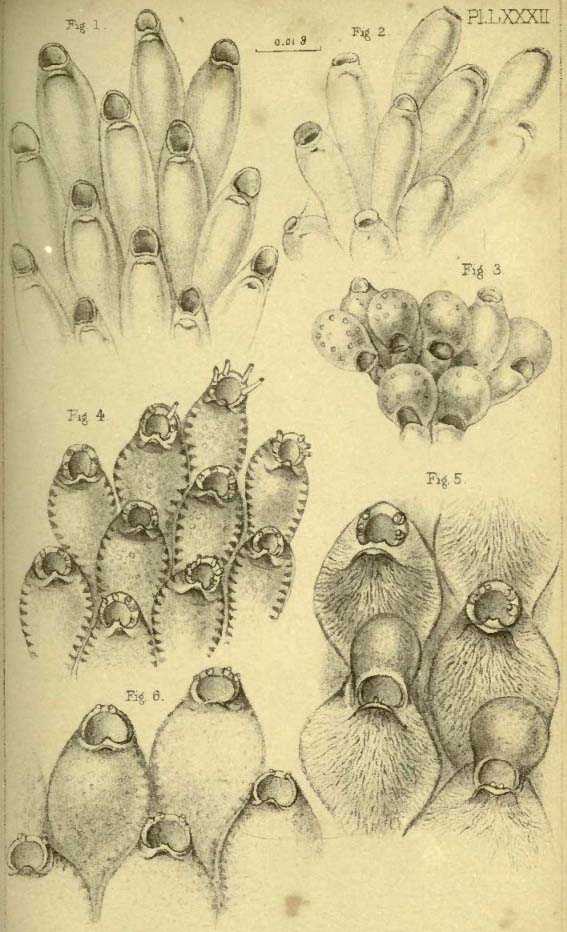
[page break]
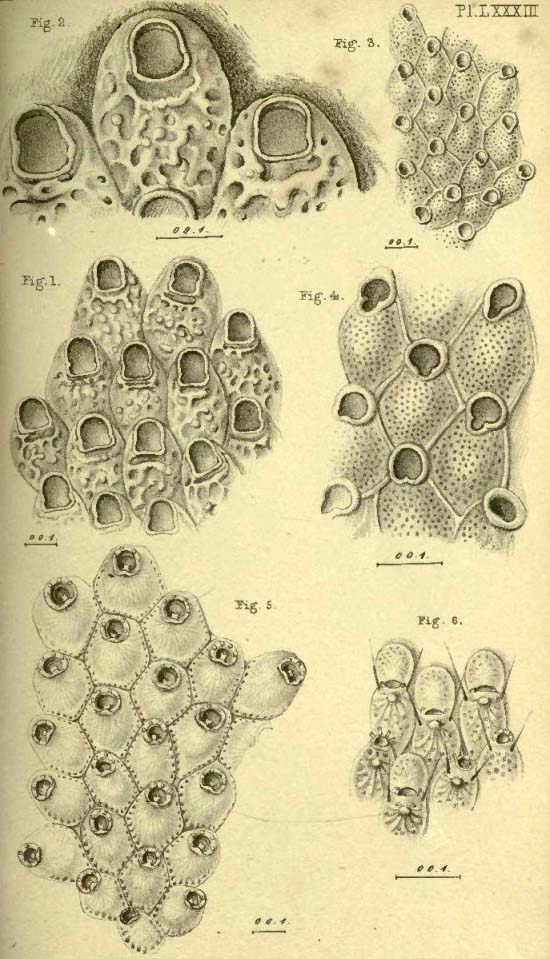
[page break]
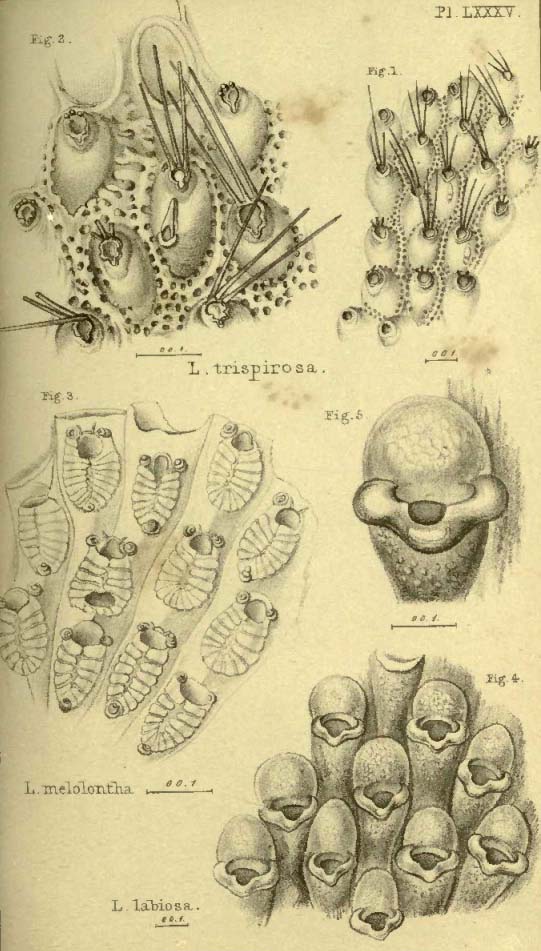
[page break]
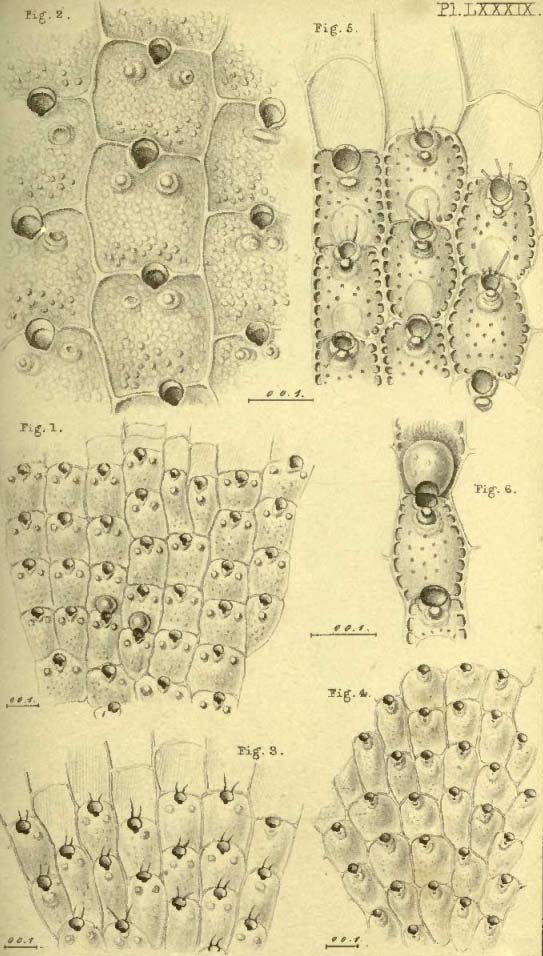
[page break]
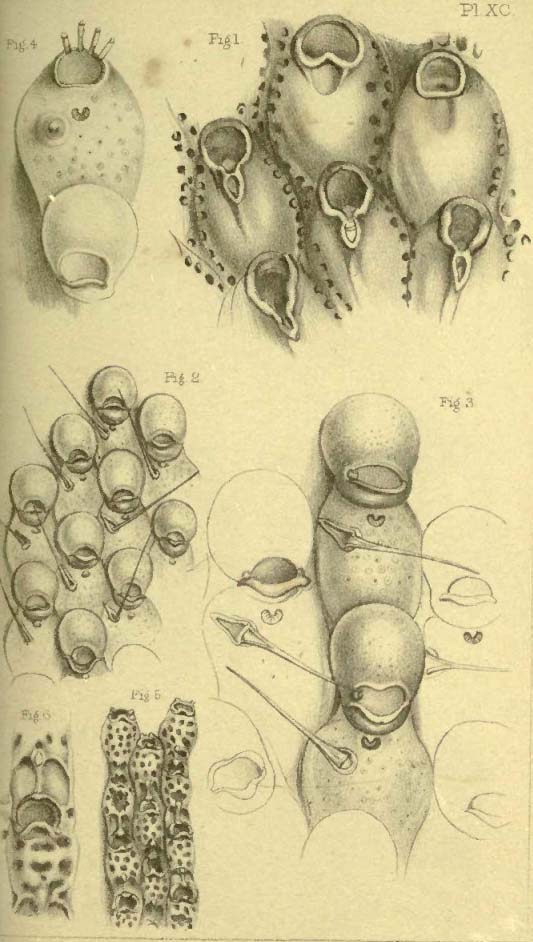
[page break]
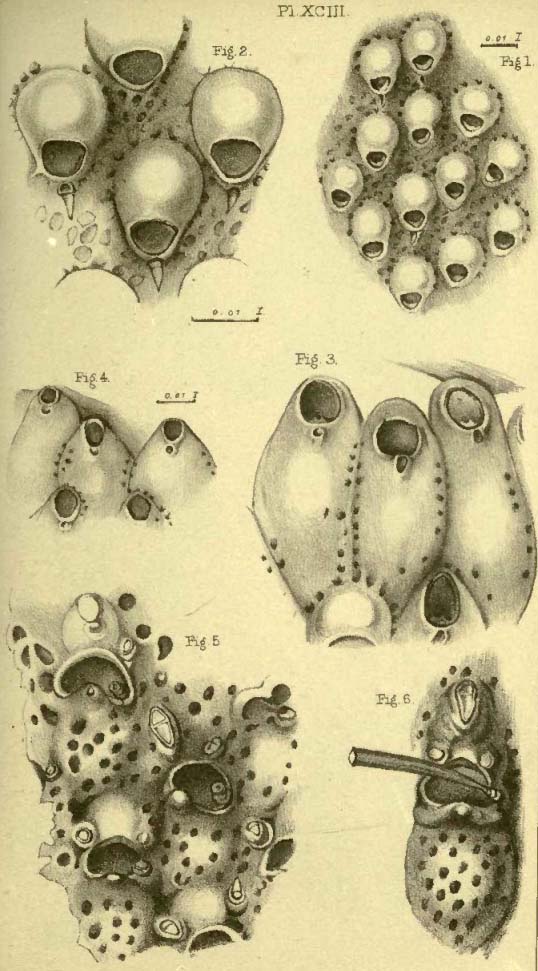
[page break]
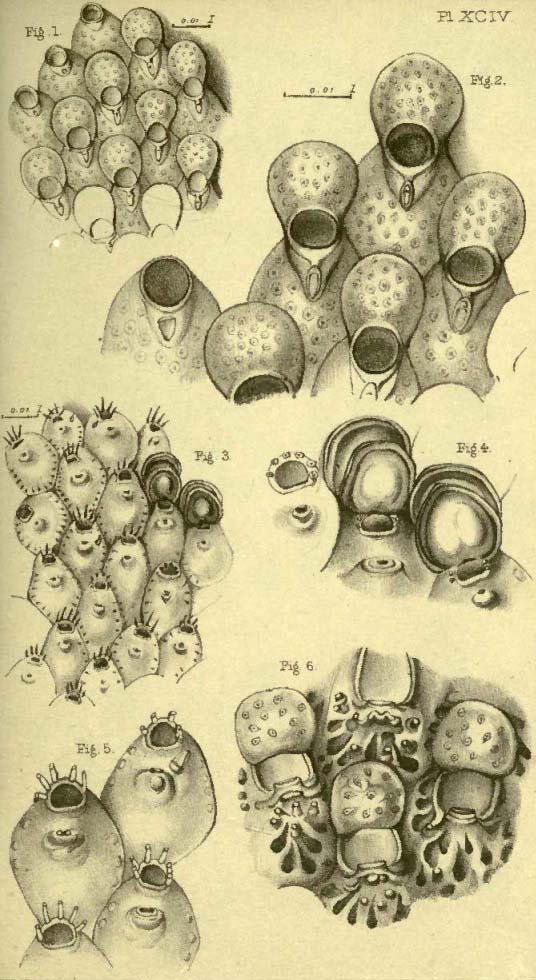
[page break]

[page break]
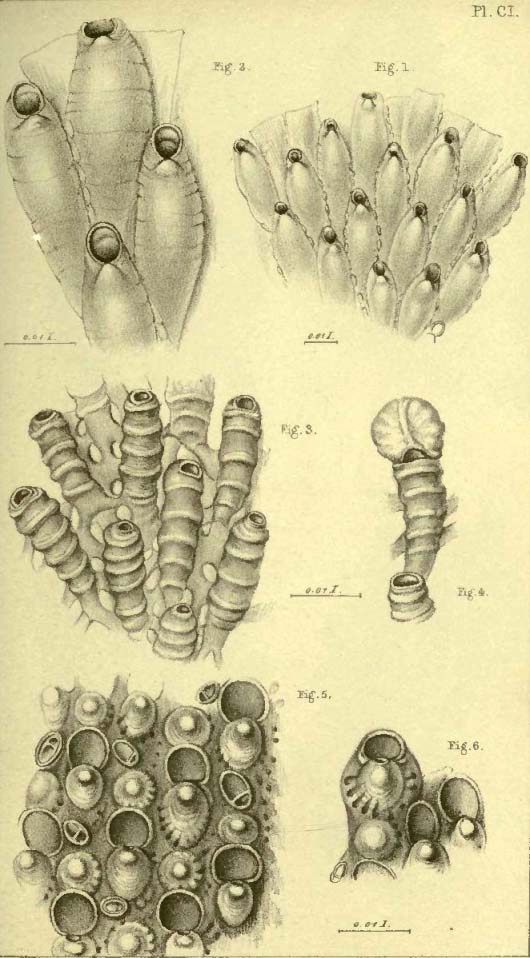
[page break]
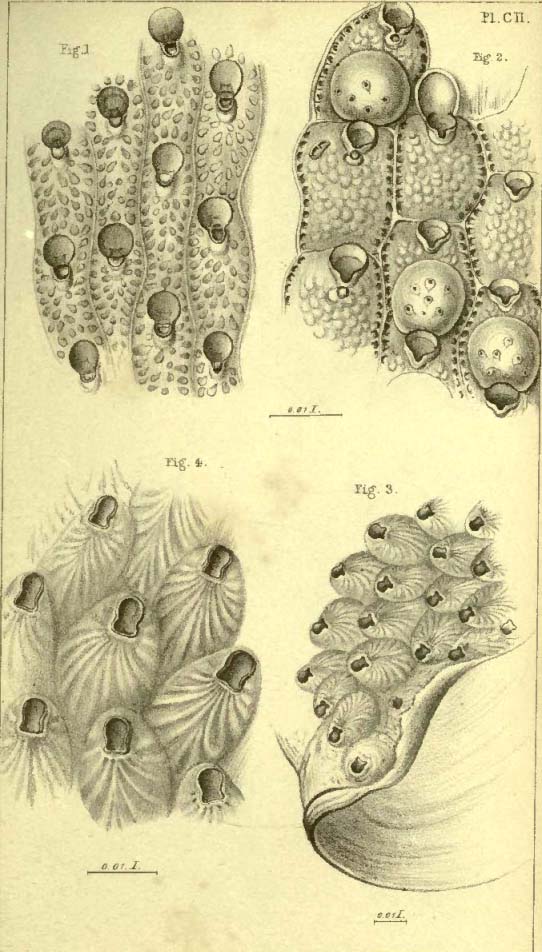
[page break]
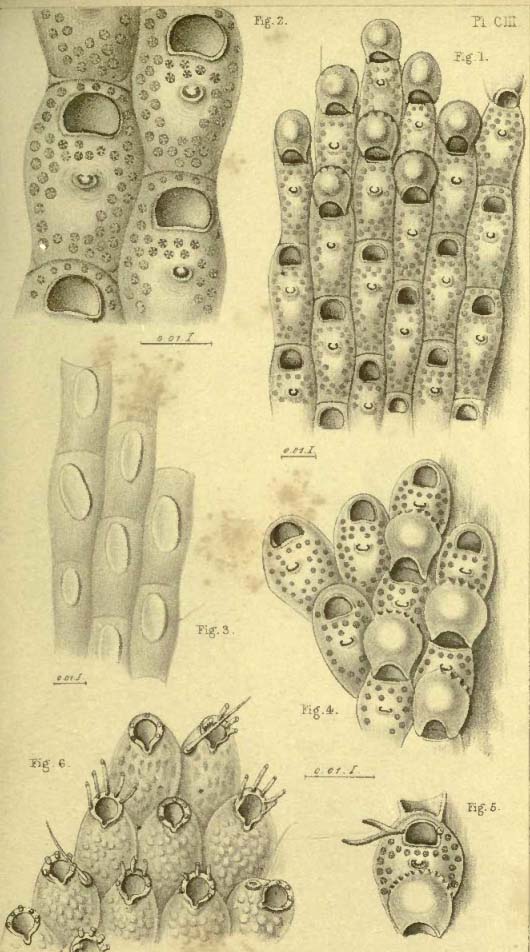
[page break]

[page break]
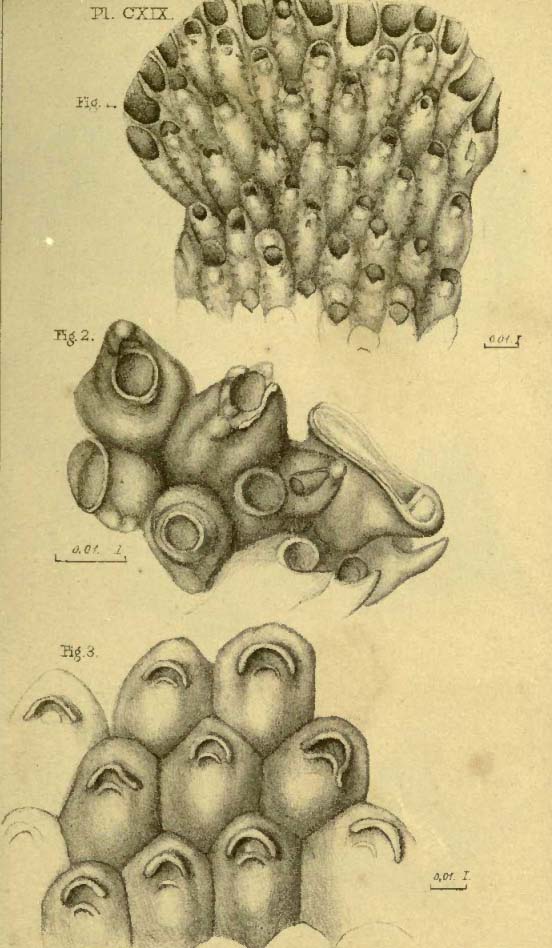
[page break]
